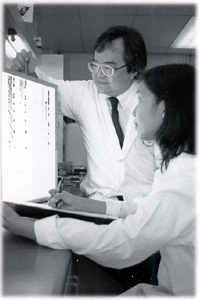

The Achievements of Dr. Skorn Mongkolsuk
 During
the past decade, research in Dr. Skorn's
laboratory can be divided into two
main phases. The first phase commenced
after joining the Department of Microbiology,
Faculty of Science, Mahidol University.
Professor Dr. Stitaya Sirisinha kindly
pointed out the problem of liver fluke
infection in the northeastern region
of Thailand and the shortcomings of
parasite (Opisthorchis viverrini)
detection by conventional methods.
With these ideas in mind, a research
project on the isolation and characterization
of repeated DNA sequence and ribosomal
RNA genes for use as DNA probes to
spectifically detect the parasite
was initiated in collaboration with
Professor Dr. Stitaya. The highly
repeated DNA sequences from O.
civerrini, and the ribosomal
RNA genes, were successfully cloned
and sequenced. Characterization of
the cloned repeated DNA showed that
it could be used as a highly specific,
but moderately sensitive DNA probe
to detect the parasite. The probe
sensitivity could be increased be
making oligonucleotide primers corresponding
to the sequence for PCR detection.
Analysis of the ribosomal RNA gene
sequence revealed variable regions
interspersed among conserved regions.
The sequence of variable regions are
ideal for making parasite specific
primers for PCR reactions which allow
highly specific and sensitive detection
of the parasite. Additional research
on finer tuning of these DNA probes
could lead to useful tools to aid
in parasite detection, rapid disease
diagnosis, and epidemiological study. During
the past decade, research in Dr. Skorn's
laboratory can be divided into two
main phases. The first phase commenced
after joining the Department of Microbiology,
Faculty of Science, Mahidol University.
Professor Dr. Stitaya Sirisinha kindly
pointed out the problem of liver fluke
infection in the northeastern region
of Thailand and the shortcomings of
parasite (Opisthorchis viverrini)
detection by conventional methods.
With these ideas in mind, a research
project on the isolation and characterization
of repeated DNA sequence and ribosomal
RNA genes for use as DNA probes to
spectifically detect the parasite
was initiated in collaboration with
Professor Dr. Stitaya. The highly
repeated DNA sequences from O.
civerrini, and the ribosomal
RNA genes, were successfully cloned
and sequenced. Characterization of
the cloned repeated DNA showed that
it could be used as a highly specific,
but moderately sensitive DNA probe
to detect the parasite. The probe
sensitivity could be increased be
making oligonucleotide primers corresponding
to the sequence for PCR detection.
Analysis of the ribosomal RNA gene
sequence revealed variable regions
interspersed among conserved regions.
The sequence of variable regions are
ideal for making parasite specific
primers for PCR reactions which allow
highly specific and sensitive detection
of the parasite. Additional research
on finer tuning of these DNA probes
could lead to useful tools to aid
in parasite detection, rapid disease
diagnosis, and epidemiological study.
 The
second phase of research work began
when Dr. Skorn moved to the Department
of Biotechnology, Faculty of Science,
Mahidol University and received a
joint appointment as head of the Laboratory
of Biotechnology, Chulabhorn Research
Institute. Thailand is a major producer
of agricultural products. Billions
of baht are lost through crop disease
and yield reduction. It is thus a
logical choice to diversify and direct
our research into this field. Consequently,
we embarked a research program on Xanthomonas, a family of
plant pathogen and soil bacteria. Xanthomona is known to infect
every economically important crop.
One active plant defense response
against bacterial infection is to
increase th synthesis of reactive
oxygen species (ROS) including H2O2,
organic peroxide, and superoxide.
ROS functions in the siganal transduction
of plant defense response in addition
to directly killing bacteria and inhibiting
proliferation. In order to grow inside
the plant, bacteria need to protect
themselves from harmful ROS. We have
discovered important physiological
parameters in Xanthomona that lead to protection from ROS.
Exposure of Xanthomona to
low levels of peroxide and superoxide
not only induce synthesis of oxidative
stress protective enzymes, such as
catalase and alkyl hydroperoxide reductase
but also confer protection against
subsequent exposure to killing concentrations
of oxidants. This inducible response
is an important component of bacterial
stress survival. To understand the
molecular mechanism of the ROS inducible
response, we adopted a multigene analysis
approach. The rational of this approach
is based on an assumption that analysis
of one structural or regulatory gene
might not give a clear understanding
of a bacterial global stress response.
Thus, the structural genes responsible
for peroxide metabolism, i.e. catalase, alkyl hydroperoxide reductase,
glutathione reductase, and a peroxide
sensor transcription regulator oxyR,
were isolated from Xanthomona.
All of these genes were characterized
at the molecular levels, and results
show that many aspects of their regulation,
chromosomal organization and biochemical
properties, differ from other bacteria.
Mutant analysis of these genes also
revealed unique physiological properties.
These results suggest that Xanthomona oxidative stress response differs
from other previously studied bacteria.
In our search for genes involved in
peroxide metabolism, we have isolated
a novel gene designated ohr for organic
hydroperoxide resistance. Analysis
of the amino acid sequence revealed
that homologues of ohr are
present in the genomes of many diverse
families of bacteria, but their functions
are still unknown. It is our hope
that current work on biochemical characterization
of Ohr will lead to clearer understanding
of its physiological role and lead
to the discovery of a new pathway
of peroxide metabolism. The
second phase of research work began
when Dr. Skorn moved to the Department
of Biotechnology, Faculty of Science,
Mahidol University and received a
joint appointment as head of the Laboratory
of Biotechnology, Chulabhorn Research
Institute. Thailand is a major producer
of agricultural products. Billions
of baht are lost through crop disease
and yield reduction. It is thus a
logical choice to diversify and direct
our research into this field. Consequently,
we embarked a research program on Xanthomonas, a family of
plant pathogen and soil bacteria. Xanthomona is known to infect
every economically important crop.
One active plant defense response
against bacterial infection is to
increase th synthesis of reactive
oxygen species (ROS) including H2O2,
organic peroxide, and superoxide.
ROS functions in the siganal transduction
of plant defense response in addition
to directly killing bacteria and inhibiting
proliferation. In order to grow inside
the plant, bacteria need to protect
themselves from harmful ROS. We have
discovered important physiological
parameters in Xanthomona that lead to protection from ROS.
Exposure of Xanthomona to
low levels of peroxide and superoxide
not only induce synthesis of oxidative
stress protective enzymes, such as
catalase and alkyl hydroperoxide reductase
but also confer protection against
subsequent exposure to killing concentrations
of oxidants. This inducible response
is an important component of bacterial
stress survival. To understand the
molecular mechanism of the ROS inducible
response, we adopted a multigene analysis
approach. The rational of this approach
is based on an assumption that analysis
of one structural or regulatory gene
might not give a clear understanding
of a bacterial global stress response.
Thus, the structural genes responsible
for peroxide metabolism, i.e. catalase, alkyl hydroperoxide reductase,
glutathione reductase, and a peroxide
sensor transcription regulator oxyR,
were isolated from Xanthomona.
All of these genes were characterized
at the molecular levels, and results
show that many aspects of their regulation,
chromosomal organization and biochemical
properties, differ from other bacteria.
Mutant analysis of these genes also
revealed unique physiological properties.
These results suggest that Xanthomona oxidative stress response differs
from other previously studied bacteria.
In our search for genes involved in
peroxide metabolism, we have isolated
a novel gene designated ohr for organic
hydroperoxide resistance. Analysis
of the amino acid sequence revealed
that homologues of ohr are
present in the genomes of many diverse
families of bacteria, but their functions
are still unknown. It is our hope
that current work on biochemical characterization
of Ohr will lead to clearer understanding
of its physiological role and lead
to the discovery of a new pathway
of peroxide metabolism.
|